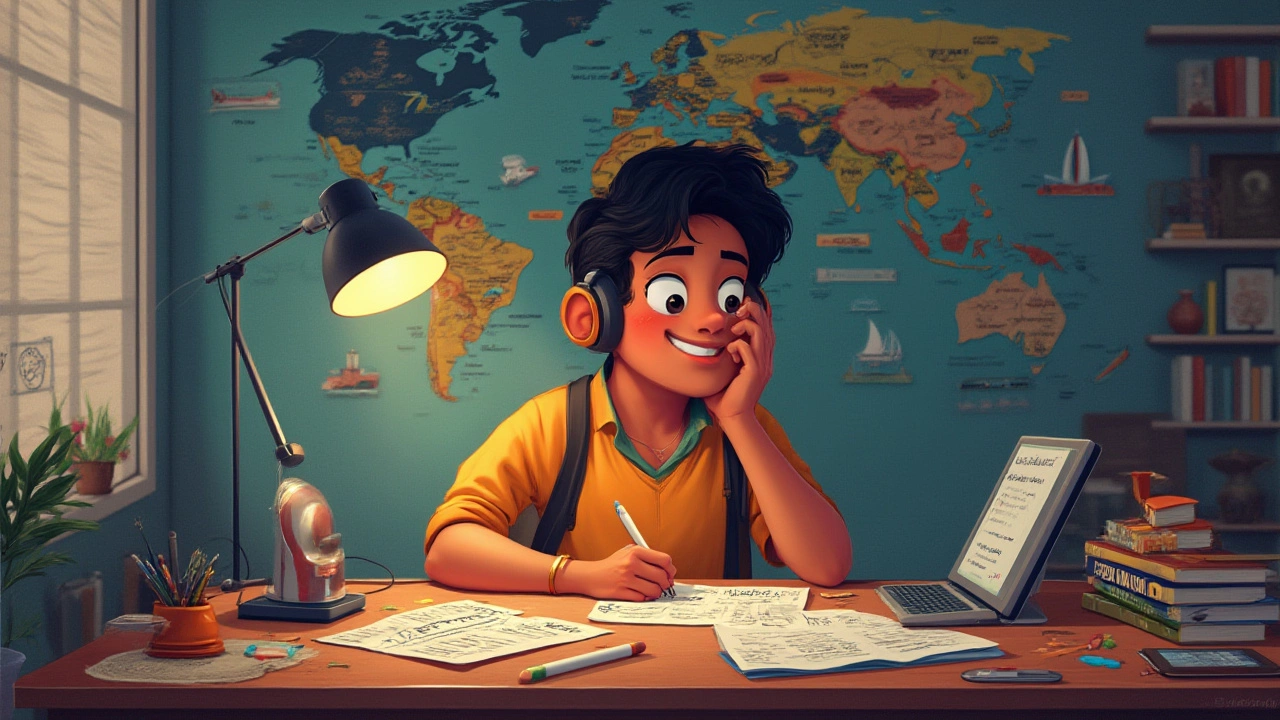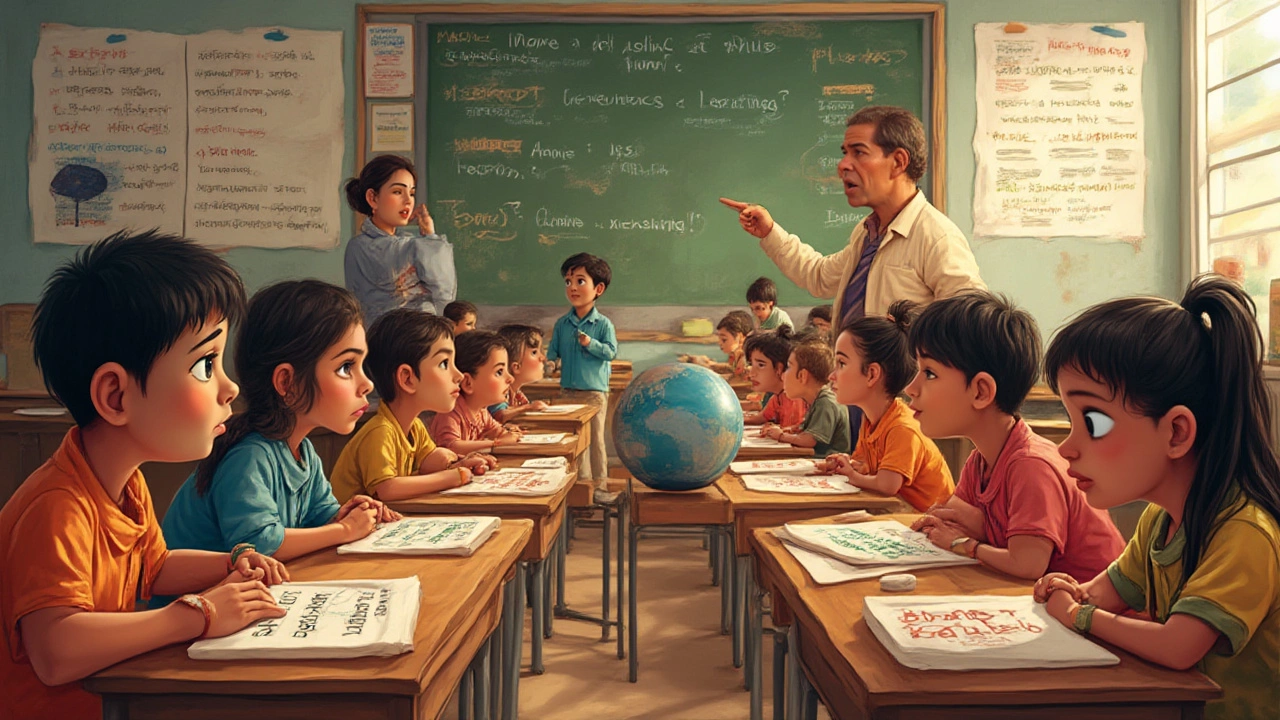You’d think with more than 7,000 languages in the world, one of them would be easier than assembling Ikea furniture with your eyes closed. But ask ten people what the hardest language to learn is, and you’ll get ten different answers—probably with a hint of groaning if you ask someone who’s tried Mandarin or Arabic. Turns out, which language is hardest kind of depends on who’s talking and what language they grew up with. Still, there are some facts and surprising quirks that set certain tongues apart when it comes to sending even enthusiastic learners into a spiral of ‘what did I just sign up for?’
Many folks assume languages with odd alphabets automatically top the difficult chart, but complexity runs deeper. It’s hiding in tones, grammar rules from another planet, or even sounds your mouth isn’t used to making. Japanese might look like ancient art class gone wild, but Finnish can twist your brain into a pretzel too. There’s no single world record-holder, but there’s plenty of debate, a fair number of myths, and more than a few fascinating details to unravel.
What Does "The Hardest Language" Really Mean?
There’s no official trophy for the 'world’s hardest language.' Instead, it comes down to a mix of things: where you’re starting from, your first language, your learning environment, and how motivated (or desperate) you are. If you’re a native English speaker, Farsi might sound alien, but a Persian kid could tell you English spelling is what’s truly puzzling. The U.S. Foreign Service Institute (FSI) actually puts out a chart showing how long, on average, it takes English speakers to learn other languages. They label them from Category I (easiest) to Category IV (hardest). If you peek at their numbers, you’ll see languages like Spanish and Dutch get a friendly 24-week mark, while Arabic, Japanese, Korean, and Mandarin Chinese each demand roughly 88 weeks—yes, more than three times as long.
So, is it just about time commitment? Not quite. Let’s dig into which features really crank up the difficulty. Unique writing systems? Check. Tons of tones or sounds your mouth isn’t used to shaping? Definitely there. Mind-bending grammar rules that seem made for robots, not humans? You bet. Tradition and culture carry weight too: Japanese and Korean each come with thick layers of polite speech, status forms, and context-driven choices. Try explaining your favorite movie to a Japanese friend and suddenly realize you need a totally different verb form to show respect. That’s enough to make even talkative folks clam up.
Here’s a look at that FSI data in a table. It’s one of the few times a chart makes you want to nap just looking at it:
| Language | Difficulty Category | Average Hours to Proficiency (English native speaker) |
|---|---|---|
| Spanish | I | 600 |
| French | I | 600 |
| German | II | 750 |
| Russian | III | 1,100 |
| Arabic | IV | 2,200 |
| Japanese | IV | 2,200 |
| Mandarin Chinese | IV | 2,200 |
| Korean | IV | 2,200 |
So when the internet throws around the label "the hardest language," it’s painting with broad, messy strokes. There’s a real mismatch between, say, an English speaker’s struggles with Polish consonants and a Chinese speaker’s confusion with French gendered nouns. But for the sake of discussion, most experts zero in on a usual gang of four: Arabic, Japanese, Korean, and Mandarin Chinese.
The Common Contenders: Why Some Languages Are Infamously Tough
Let’s see just what makes Arabic, Mandarin, Japanese, and Korean so tough to crack for most learners.
- Arabic doesn’t have a shortage of speakers—it’s one of the top five languages used worldwide, but it’s got a reputation. The script flows right to left, and it’s got its own looping calligraphy vibe. Each letter hooks up with the rest differently depending on its position in the word. Vowel sounds? Ghost-like in standard writing—they’re usually just dropped. Add to this a buffet of regional dialects (the spoken “street” Arabic in Morocco can be worlds apart from what you’ll hear in Jordan), and you might feel lost even after learning the basics.
- Mandarin Chinese looks deceptively friendly if you just hear it spoken for five minutes. But then you meet the writing system—thousands of characters, each its own mini-puzzle—and realize you can’t read a menu without memorizing stacks of symbols. It’s also tonal, with four main tones in Mandarin that can totally change a word’s meaning. For example, ‘ma’ in one tone is “mother,” in another it’s “horse.” That’s not a typo. Imagine trying to order food and accidently calling the chef a farm animal. Not pretty.
- Japanese is a one-two punch. There are three scripts—Hiragana, Katakana, and Kanji—often used together, sometimes in the very same sentence. Kanji on its own takes years to master, and even Japanese kids are still learning new ones in high school. Layer on a culture of politeness that requires you to switch speech forms depending on who you’re talking to, and the simplicity of the spoken language suddenly gets complicated. Even figuring out if the verb comes at the end can twist your brain.
- Korean at least makes you feel clever at first. Its writing system, Hangul, is famous for being logical—you can learn it in a weekend. But speaking? Oh boy. Expect grammar structures unlike anything in English, and entire layers of politeness built right into the words. Pronunciation brings new sounds, too—if your tongue’s only experienced English, get ready for a workout.
Other languages could easily grab the ‘hardest’ title depending on who you ask. Polish throws a million consonants in a row and dares you to read them out loud. Hungarian grammar breaks more hearts than online dating. Finnish is notorious for having 15 noun cases, far more than most European languages. If this is starting to sound intimidating, it should—it is. But if you approach it with curiosity (and a good sense of humor), it’s nowhere near impossible.

Bizarre Features That Make Learning Some Languages a Nightmare
So, what exactly makes some languages feel like they're conspiring against new learners? Let’s look at some features you almost never encounter as an English speaker, but that are perfectly normal in other parts of the world.
- Tones. Vietnamese, Mandarin, Thai—all use tones to change the entire meaning of a word. So one syllable, spoken five different ways, could mean five completely separate things. Imagine if every time you said “cat” with the wrong pitch, you’d accidentally said “cupcake,” “car,” “quicksand,” or “grandma” instead.
- Cases. Some languages like Russian, Finnish, and Hungarian use multiple cases for nouns, meaning you have to change the word endings to show who’s doing what. English has a couple: think “he/him/his.” Now imagine doing that with every noun, every single time—and remembering if it’s in the correct case, gender, and number.
- Click sounds. Zulu and Xhosa use clicks as actual letters. Trying to mimic these as an outsider will feel awkward... at first. But the people who speak these languages make it sound easy, of course.
- Writing systems designed to make you sweat. Mandarin, Cantonese, Japanese, and Korean have writing systems that either use thousands of unique characters or blend alphabets. Even Hindi and Thai scripts require you to unlearn the familiar ABCs and start from scratch.
- Phonemes galore. Georgian and Polish both stack up sounds you never thought could live side-by-side in a word. “Cześć” in Polish (meaning “hi”) is a classic challenge for newbies.
- Invisible vowels or vowels written only sometimes. Arabic and Hebrew scripts often leave vowels out unless you’re reading a children’s book or poetry, which feels like a cruel prank when you’re new.
The deeper you get, the weirder stuff can get. Take the Pirahã language, spoken in the Amazon. It has no words for numbers—and some claim it even lacks subordinate clauses (like “when I went home…”). Or look at Navajo, which helped the Allies win WWII because its structure and vocabulary were so tricky, no codebreakers could crack it. If you thought learning new vocabulary was all you’d need, think again.
Tips If You're Brave Enough to Tackle a Difficult Language
Let’s get practical. Maybe you want to set a challenge, connect with your heritage, or just love puzzles. If you’re ready to climb the Mount Everest of languages, here are some honest tips to actually survive and thrive during the climb:
- Get comfortable being confused. Feeling lost is part of the process. Even after months of study, tricky languages throw curveballs. Accepting this keeps you moving forward.
- Focus on patterns, not memorization. While flashcards help, recognizing patterns in grammar and pronunciation makes languages like Japanese or Finnish less chaotic.
- Practice with real people ASAP. Nothing replaces conversation—apps are good, but awkward, real-life chats help you remember things like which tone to use or when to bow (figuratively or literally).
- Immerse yourself. Watching movies, listening to music, and reading even simple comics gets your brain soaking in how the language works outside the classroom.
- Celebrate tiny victories. Maybe you ordered food without accidentally asking for a horse in Mandarin, or you recognized a single Kanji on a sign. These count, and they keep you motivated.
- Don't get scared by scripts. Most "extreme" scripts look intimidating, but break them down piece by piece. Hangul, for instance, has a logic that’s almost mathematical. Kanji? Start with the ones you’ll see every day, not rare historical ones.
- Find your weird motivator. Love K-Pop or manga? Learning for travel? A personal connection goes a long way on the days when nothing makes sense.
- Laugh at your mistakes, and learn from them. Everyone will stumble—a lot. If you can laugh about it instead of freeze up, you'll move ahead faster.
More importantly, remind yourself that “hard” is relative. Young kids pick up even wild languages fast, mostly because they use them in real life all the time. Adults need to work a little (or a lot) harder and shrug off embarrassment, but that actually makes each achievement much sweeter.
According to language gurus from the polyglot community, the best learners keep things fun, keep tools handy (like browsing Japanese menus or tuning in to Korean soap operas), and set goals smaller than "mastery." If you can introduce yourself, order coffee, or tell someone their dog is cute, you’re making real progress.
It’s easy to get intimidated by the challenge. But with the right approach, stubbornness, and actual human contact, hard languages start looking a little less like moody foreign monsters and more like a cool, achievable challenge. And hey, the moment you communicate something that once seemed impossible? Feels like winning a gold medal—at least for that day.
